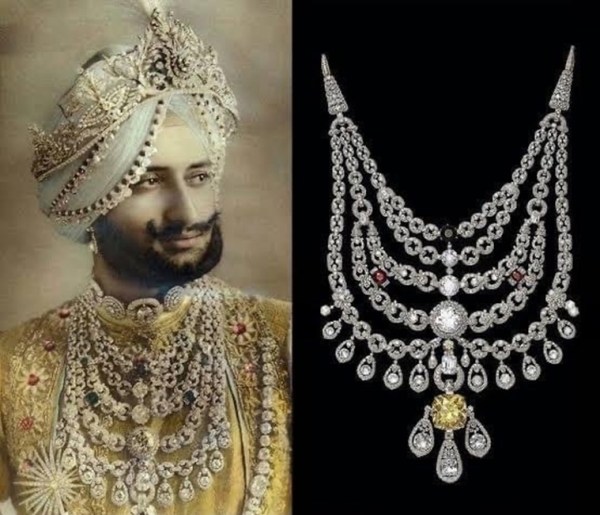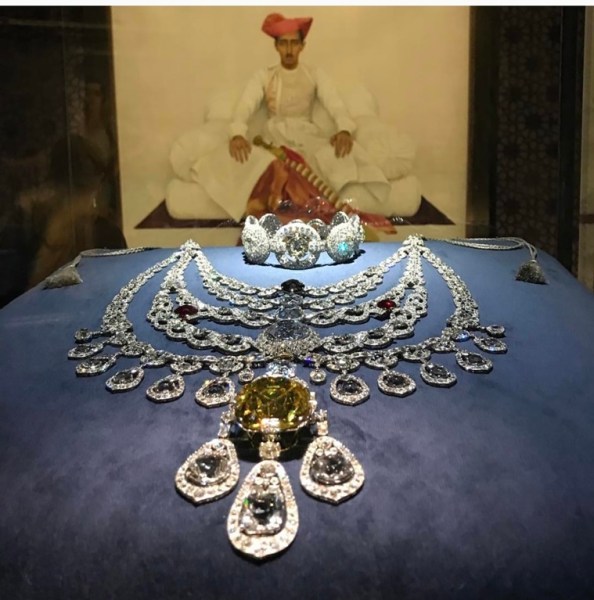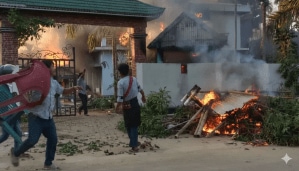Nearly a century after Maharaja Bhupinder Singh, the erstwhile ruler of the princely state of Patiala, commissioned jewellery giant Cartier to create one of the costliest pieces of jewellery ever made — the Patiala Necklace — the magnificent piece of jewel returned to the limelight. Popular US YouTuber Emma Chamberlain has been facing widespread criticism for wearing a ‘choker’ similar to the one with the necklace to this year’s Met Gala.
The necklace was said to have disappeared from the Royal Treasury of Patiala around 1948, and parts of it, including the massive De Beers diamond, were later purchased by Cartier.

The grandeur of the necklace can be gauged from the fact that it had taken three years for Cartier to complete the jewellery. Had the original creation existed today, with all its diamonds, it would have been valued at anything between $30-50 million.
However, the necklace continues to remain a matter of mystery for not just historians but also members of Patiala’s royal household.
The latest controversy
The Patiala necklace was a set of five platinum chains joined together and studded with at least 2930 diamonds, rubies, emeralds and one of the largest diamonds — De Beers — at its centrepiece. However, in most of the available photographs, it is Maharaja Bhupinder Singh’s son and successor, Maharaja Yadavindra Singh — the last ruler of Patiala from 1938 till merger of the princely state with the Union of India in 1948 — who can be seen wearing the necklace along with a diamond studded ‘choker’ (a neckpiece firmly fitting to the neck). It is believed that after 1948, the entire set, including the necklace and the choker, was either ‘stolen’ or ‘went missing mysteriously’ from Patiala’s Royal treasury. Decades later in the 1980s, Cartier traced and purchased some remains of the Patiala Necklace, but found many of its gemstones missing. The luxury brand tried to restore the grand jewel by replacing the diamonds with replicas.
 Maharaja Yadavindra Singh and the necklace. (Express photo/Sourced)
Maharaja Yadavindra Singh and the necklace. (Express photo/Sourced)
Recently, at the Met Gala held in New York, American celebrity and YouTube influencer, Emma Chamberlain, made an appearance wearing a diamond studded choker, similar to what Maharaja Yadavindra Singh qA seen wearing in the photos along with the necklace. Soon after the Gala, historians and others had started posting the Maharaja’s photos online and questioning if it was the same necklace that was once owned by the Patiala Royals. They questioned how a ‘stolen piece of heritage’ that ‘belonged to India’ had reached the West.
Interestingly, Chamberlain also credited Cartier for her jewellery on her official Instagram page, facing massive backlash from Indians for wearing the choker.
The grand ‘Patiala Necklace’ is one of its kind
Story continues below this ad
The 2019 book ‘Untold Story of the Family behind the Jewelry Empire – The Cartiers’ written by Francesca Cartier Brickell, granddaughter of late Jean Jacques Cartier, one of the members of the Cartier family who ran the London branch of the firm, has a dedicated chapter titled ‘Jewelry Spotlight: The Patiala Necklace’ detailing the magnificence of the creation.
Giving the details of how the Maharaja had commissioned Cartier to make the ‘Patiala Necklace’ to ‘update his heirloom into a collection that would put his fellow Indian rulers in the shade’, Brickell writes, “In the summer of 1925, the head Cartier Paris salesman was summoned.. by a very distinguished client. One of the richest men in the world, Maharaja Bhupinder Singh of Patiala didn’t do things by halves. With five wives and a world-renowned appetite for every conceivable type of luxury, from Rolls Royces to aircraft to diamonds, he personified Eastern Splendor…”
 Maharaja Bhupinder Singh of Patiala, who commissioned the necklace to Cartier, with six of his consorts. (Express photo/Sourced)
Maharaja Bhupinder Singh of Patiala, who commissioned the necklace to Cartier, with six of his consorts. (Express photo/Sourced)
Cartier salesman M Muffat, who went to meet the Maharaja at Hotel Claridge of Paris was shown a treasure, several Burmese rubies and ‘a diamond as large as a thumbnail’, writes Brickell, along with ‘white, brown, yellow diamonds with a greenish tint, others with a hint of pink..red rubies, vivid green emeralds. “Muffat, a connoisseur of gemstones, tried hard to hide his awe..”
“The Maharaja told Muffat that he was looking for his gems to be reset in a more modern style.. worthy of a king,” reads an excerpt. But the task wasn’t going to be easy.
Story continues below this ad
“It would take Cartier three years to turn Maharaja’s gems into a collection of jewels that would go down in jewellery history. More than two hundred pearls were drilled to make a single bracelet. But the pièce de résistance was a necklace of such brilliance that it outshone everything else. Containing a staggering 2,930 diamonds and weighing over a thousand carats, it was mounted in platinum and enhanced by Burmese rubies. And at its center was the yellow 234.6-carat De Beers diamond, the size of a golf ball and the seventh-largest diamond in the world,” writes Brickell, describing the making of one of the costliest pieces of jewels ever created.
‘Missing or stolen’ — Patiala royal scion denies both
What continues to amaze historians is how facts related to the ‘disappearance’ of the necklace after 1948 continues to be a mystery even for the members of the royal family.
 The ‘disappearance’ of the necklace after 1948 continues to be a mystery even for the members of the royal family. (Express photo/Sourced)
The ‘disappearance’ of the necklace after 1948 continues to be a mystery even for the members of the royal family. (Express photo/Sourced)
Brickell writes in her book that the necklace had gone ‘missing’: “The Patiala necklace sparkled under the Indian light for two generations, a symbol of power, wealth and exquisite European taste, but in 1948 it sparked controversy when it was reported missing from the Patiala Royal treasury. Nothing was heard of it for a further thirty-four years, at which point the De Beers diamond mysteriously reappeared, without the necklace, at a 1982 Sotheby’s auction (valued at $ 3 million). Sixteen years after that, part of the necklace appeared in a small antiques shop in London. Obviously, the De Beers stone was missing but so were all other diamonds. It was bought by Cartier, who replaced missing stones with replicas.”
Maharaja Bhupinder Singh had four wives and hundreds of other consorts, and in all he had 88 children, of which 54 survived. He died in 1938. He was succeeded by Yadavindra Singh who was the last ruler of Patiala till 1947, and died in 1974.
Story continues below this ad
The royal family scion Captain Amarinder Singh, former Punjab Chief Minister and Maharaja Yadavindra Singh’s son, says that though he has some memories of seeing his father wearing the necklace, he has ‘never came across it personally’ and was ‘not even born when his grandfather died in 1938’.
 Maharaja Yadavindra Singh wearing the Patiala necklace along with the choker. (Express photo/Sourced)
Maharaja Yadavindra Singh wearing the Patiala necklace along with the choker. (Express photo/Sourced)
He adds that ‘according to family elders, the necklace was never stolen’. “I remember that my father wore it on Dussehra darbar. My grandfather had 54 children so probably it was dismantled and distributed as dowries and gifts among the children who sold it further. I never saw it, but it was not stolen. Cartier had tried to reassemble it,” Amarinder told The Indian Express.
‘A mystery that will continue to be’
Amarinder’s younger brother, Malwinder Singh, however differs from his brother and says that he doubts if the necklace was dismantled and distributed among 54 children of Bhupinder Singh as he had ‘other things to give.’
He feels that the mystery of the necklace will continue to be a mystery .
Story continues below this ad
“We were too young, but yes I saw my father wearing it for the last time on April 13, 1948, on Baisakhi Darbar at Moti Bagh Palace. I was just 4 and Amarinder was 6. It was never traced after that. After my grandfather’s death in 1938, my father only wore it for a short while. I asked my mother about it but she wasn’t aware of it. In those times, wife or children never used to question the head of the family. Around 20 years ago, I met Cartier representatives in Delhi who said that they recovered the necklace in bits and pieces. My father must have been aware that it was sold or gifted or whatever, but we never asked him about it. ,” said Malwinder.
Newsletter | Click to get the day’s best explainers in your inbox
Did Chamberlain wear the choker that once belonged to the Patiala Royals?
UK-based historian, Amar Singh Panesar, says that only an access to Cartier archives could confirm the source of the choker or if it was a replica created by the company. “It remains a mystery who actually sold the necklace or its pieces and to whom, maybe it was someone from within the royal family.”
Story continues below this ad
 US YouTuber Emma Chamberlain seen wearing a ‘choker’ similar to the one with the necklace at this year’s Met Gala. (Express photo/Sourced)
US YouTuber Emma Chamberlain seen wearing a ‘choker’ similar to the one with the necklace at this year’s Met Gala. (Express photo/Sourced)
“But we also don’t know if the choker was also a part of the set when the necklace was sold. So there could be three possibilities: The choker was a loan and returned to Cartier; or it was sold back to Cartier or the one Emma wore was a replica. We cannot verify if the choker was also a part of the Patiala necklace or was commissioned later or maybe it was sold later separately. Only Cartier can verify it from its archives.”
The Indian Express tried to contact Cartier for a comment via mail. The company in its initial reply said that one of their representatives would get back but later no reply was received till the filing of this report.



 Maharaja Yadavindra Singh and the necklace. (Express photo/Sourced)
Maharaja Yadavindra Singh and the necklace. (Express photo/Sourced) Maharaja Bhupinder Singh of Patiala, who commissioned the necklace to Cartier, with six of his consorts. (Express photo/Sourced)
Maharaja Bhupinder Singh of Patiala, who commissioned the necklace to Cartier, with six of his consorts. (Express photo/Sourced) The ‘disappearance’ of the necklace after 1948 continues to be a mystery even for the members of the royal family. (Express photo/Sourced)
The ‘disappearance’ of the necklace after 1948 continues to be a mystery even for the members of the royal family. (Express photo/Sourced) Maharaja Yadavindra Singh wearing the Patiala necklace along with the choker. (Express photo/Sourced)
Maharaja Yadavindra Singh wearing the Patiala necklace along with the choker. (Express photo/Sourced) US YouTuber Emma Chamberlain seen wearing a ‘choker’ similar to the one with the necklace at this year’s Met Gala. (Express photo/Sourced)
US YouTuber Emma Chamberlain seen wearing a ‘choker’ similar to the one with the necklace at this year’s Met Gala. (Express photo/Sourced)




































